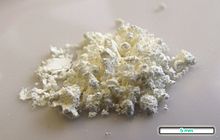Amiloride
| Structural formula | |||||||||||||
|---|---|---|---|---|---|---|---|---|---|---|---|---|---|

|
|||||||||||||
| General | |||||||||||||
| Non-proprietary name | Amiloride | ||||||||||||
| other names |
|
||||||||||||
| Molecular formula | C 6 H 8 ClN 7 O | ||||||||||||
| Brief description |
pale yellow to greenish yellow powder (amiloride hydrochloride) |
||||||||||||
| External identifiers / databases | |||||||||||||
|
|||||||||||||
| Drug information | |||||||||||||
| ATC code | |||||||||||||
| Drug class | |||||||||||||
| properties | |||||||||||||
| Molar mass | 229.63 g mol −1 | ||||||||||||
| Physical state |
firmly |
||||||||||||
| Melting point |
293 ° C (amiloride hydrochloride ) |
||||||||||||
| pK s value |
8.7 |
||||||||||||
| solubility |
|
||||||||||||
| safety instructions | |||||||||||||
|
|||||||||||||
| As far as possible and customary, SI units are used. Unless otherwise noted, the data given apply to standard conditions . | |||||||||||||
Amiloride is a drug from the group of potassium-sparing diuretics (dehydrating agents). It is used in combination with another diuretic substance - usually hydrochlorothiazide - to treat potassium deficiency caused by heart failure and to treat high blood pressure . Amiloride came onto the market in 1967 as a drug (Moduretik ® , MSD Sharp & Dohme).
Chemically speaking, amiloride is a pyrazine derivative . It also contains a guanidino group. Amiloride is sensitive to light.
Mode of action
The effect of amiloride is based on a direct blockage of the epithelial sodium channel (ENaC). This is located, among other things, in the distal section of the tubular system of a kidney nephron, where it ensures that sodium ions are taken up again from the primary urine. By inhibiting the re-uptake of sodium, amiloride leads to an increased loss of sodium and water without increasing the excretion of potassium .
Pharmacological properties
Amiloride is always used together with a thiazide diuretic or loop diuretic . The potassium-sparing effect can lead to an increase in the blood potassium level up to hyperkalaemia . The risk of this is increased when taking ACE inhibitors or aldosterone antagonists at the same time . Contraindications are hyperkalemia (increased blood potassium level), pregnancy and anuria (abnormally reduced urine production).
By inhibiting the reuptake of sodium, amiloride is a suitable agent for patients with Liddle's syndrome who suffer from hypertension due to their genetic excess of sodium in the blood.
Pharmacokinetics
After oral intake, the maximum blood plasma concentration occurs after about 4 hours. 50% of the absorbed dose is bioavailable , 50% is excreted renally and 50% in the stool . There is hardly any metabolism; the majority is eliminated unchanged . Amiloride has a half-life of about 18 hours.
Exploring other properties
In a mouse model of cystic fibrosis , Zhou and colleagues showed that inhaled amiloride in the first few days of life prevents the typical symptoms of cystic fibrosis and the development of a chronic lung disease. However, if the symptoms were already present, there was no improvement from the treatment. Chronic lung damage appears to prevent amiloride from working. This suggests that the changes that the disease causes in the lungs may be irreversible.
Further use
The property of the amiloride to block the epithelial sodium channel is also used in research into the sense of taste . ENaC is located in the taste sensory cells on the tongue and in the throat and is involved in the perception of the taste of salt. Amiloride inhibits the receptor for sweet taste by binding to T1R2 .
Commercial preparations

- Combination preparations
Amiloretik (D, A), Comilorid (CH), Diaphal (D), Diursan (D), Ecodurex (CH), Escoretic (CH), Kalten (CH), Loradur (A), Moducrin (D), Moduretic (A , CH), Rhefluin (CH), Tensoflux (D), various generics (D, A, CH)
Other properties
Amiloride hydrochloride fluoresces in ultraviolet light (at 365 nm wavelength ). This is used in the detection of the thin-layer chromatographic identity check according to the European Pharmacopoeia .
Amiloride hydrochloride contains about 12% water of crystallization; the release of water of crystallization when heated affects the melting point.
Individual evidence
- ↑ a b AMILORIDE HYDROCHLORIDE CRS data sheet (PDF) at EDQM , accessed on September 22, 2009.
- ↑ Harry Auterhoff , Joachim Knabe, Hans-Dieter Höltje: Textbook of Pharmaceutical Chemistry. 14th edition. Wissenschaftliche Verlagsgesellschaft, 1999, ISBN 3-8047-1645-8 .
- ↑ a b c H. PT Ammon (Ed.): Hunnius. Pharmaceutical Dictionary. 9th edition. de Gruyter, 2004, ISBN 3-11-017487-1 .
- ↑ a b c d European Pharmacopoeia 6.2
- ↑ a b c d e Pharmacopoeia Commentary. Complete works including 36th update delivery 2010, ISBN 978-3-8047-2461-7 .
- ↑ a b Data sheet Amiloride hydrochloride hydrate from Sigma-Aldrich , accessed on March 20, 2011 ( PDF ).
- ↑ a b c D. Steinhilber, M. Schubert-Zsilavecz, HJ Roth: Medicinal Chemistry. Targets and Drugs. Deutscher Apotheker Verlag, Stuttgart 2005, ISBN 3-7692-3483-9 .
- ↑ Z. Zhou, D. Treis, SC Schubert, M. Harm, J. Schatterny, S. Hirtz, J. Duerr, RC Boucher, MA Mall: Preventive but not late amiloride therapy reduces morbidity and mortality of lung disease in βENaC- overexpressing mice. In: Am J Respir Crit Care Med. 178, 2008, pp. 1245-1256.
- ↑ M. Zhao, XQ Xu, XY Meng, B. Liu: The Heptahelical Domain of the Sweet Taste Receptor T1R2 Is a New Allosteric Binding Site for the Sweet Taste Modulator Amiloride That Modulates Sweet Taste in a Species-Dependent Manner. In: Journal of molecular neuroscience: MN. [Electronic publication before printing] August 2018, doi: 10.1007 / s12031-018-1156-5 , PMID 30120716 .